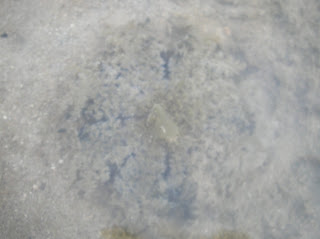We were back in Semakau on 25th July for hunting-seeking survey. My partner-in-crime and I were upgraded to survey sponges and corals, in addition to algae. I must have gotten addicted to them because its the first time I emptied my camera battery after taking more than 150 photos of corals, sponges and algae! Nonetheless, I will not blog about them now because it will take me a very long time to figure out the species (and I might turn into stone in the process of identifying them)!
So for now, let the limelight be the overnight stay and the exclusive walk of a less explored part of the intertidal area. After our hunting-seeking survey, we had a great time flying kites in the afternoon at the southern point. Less enjoyable was the jog back to NEA office (yes, don't remind me that its my silly idea), the sun was so scorching that we all turned into cooked lobsters! At night, our spirits were also not dampened by the non-existent fireworks (which was supposed to be one of the highlights of the stay!), because replacing the fireworks were stunning trees lit by fireflies - up close and personal.
We woke up early the next morning (26 Jul) for another intertidal walk. Once again, the weather was not cooperative and it started raining cats and dogs. Good thing we were only delayed by 15mins and we could proceed as planned!
My first encounter with the Cryptic rock star (Cryptasterina sp.)! I never knew it was so tiny, this one was probably only 2-3cm wide. Interestingly, this rock star has 6 arms, instead of the more common 5-armed.

This fierce predator obtains its food by wrapping its foot around its prey to suffocate it. If all else fails, it secretes an acid to soften the victim's shell, creates a hole with its radula and sucks out the contents! How cruel and ferocious can one get?
Its my first time seeing the Hell's Fire Anemone (Actinodendron sp), after hearing so much about its very painful stings. 真是久仰大名. This anemone is often mistaken with the Upside-down Jellyfish (by me!), because of its similar appearances (see both pictures for comparison). A clear distinction is the white stripes radiating from the anemone's mouth (though not clearly depicted in this photo), as well as the distinct trigular-shaped branches.
Hell's Fire Anemone
Upside down Jellyfish




video of Upside-down jelly fish - obviously uncomfortable when they are right-side-up!

Happy smiles were on everyone's faces as we all had good harvest in this pristine part of Semakau. Hope to have more chances of exploring this area of this amazing island!A pair of keen eyes (not mine definitely) spotted these squid egg capsules.
Before I could even finish taking a good shot of the egg capsules, there were shouts from some volunteers a distance away asking us to avoid a particular area. Instead of heeding their advice, our curiousity drew us to them. The perpetually grouchy and frowning, highly venomous Stone Fish (Synanceja horrida) was found! Do not underestimate this fish whose ugly look aids in its camouflaging, a careless step (esp since its camouflaged as a stone!) on its spines can be lethal.
Another volunteer spotted the harmless (to human beings at least) Banded File Snake (Acrochordus granulatus). This is a noctoral snake, mostly spotted at night or in the early mornings. They feed mainly on small fishes, and appararently gives birth to live young!
I saw a couple of nudibranchs on this trip, including the Phyllidiella Pustulosa. Nudibranchs , which means naked gills in latin, are a type of sea slug. They are named after their exposed gills on the back of its body. These slugs are born with shells, but loses them as they become adults. To protect themselves, they develop toxic or bad tasting glands on its body and warns predators via its bright colours. Rule of thumb in the animal kingdom - avoid the brightly coloured!
Another slug, the Blue Dragon (Pteraeolidia Iantina) was also found.
The area is fairly rich with corals and as I walked on, I saw several Sunflower Mushroom Coral (Heliofungia actiniformis). While each hard coral is a colony made of many polyps (akin to a condominium), the Sunflower mushroom coral is a single polyp (akin to a landed bungalow) instead. This free-living coral does not attached itself to any surface and has fat, white-tipped tentacles. It is often mistaken as an anemone, but its hard skeleton disk would be the sure give-away.
Also in abundance is the Gigantic carpet anemone (Stichodactyla gigantea). Anemones have stinging cells that affects most animals except for the anemone fish, which has a symbiotic relationship with the anemone. The fish protects the anemone from predators such as the butterfly fish, and in turn obtains shelter from the anemone. Disappointedly, I was uanble to spot find any nemos, unlike the other volunteers.
Fan worms (Sabellastarte indica) were also easy to spot. Fan worms are segmented worms that feed on detritus in the water. They live in a flexible tude that is made of sand, saliva and mucus. If only we have this skill of building our houses in this manner, then we will not be affected by the current mad scaling property prices! Apart from providing a hiding place whenever the worm senses danger, the tubes also keeps them moist and safe, if they happen to be exposed at low tide.

I had to battle (and of course, none were hurt in the process) a few fierce Red Swimming Crabs (Thalamita Spinimala) as they wave their pincers in an attempt to intimidate me, when all I really wanted to do, was to take a pretty photo of it. Such ingrates! Swimming crabs are agile swimmers due to their last pair of paddle-liked legs. Although blessed with this skill, they are often bottom dwellers. Their long pincers are used to catch prey eg fish (and also to intimidate people like me!).

A few steps away from the Red Swimming Crab, I noticed a fish lurking in the shadows. On a closer look, it appeared to be a very well camouflaged stingray. This was soon confirmed, as it quickly dart out of the sand, as I inched closer to it. Famed by its distant relative who killed Steve Irwin, it is known that they fend off predators with the flick of its tail which has venomous spines, especially when they are caught off guard. So don't startle them unless you are feeling very brave!

As the tide started to rise, we made our way back. Along the way we saw 2 Upside-down jellyfishes side by side. The Upside-down jellyfish (cassiopea sp) got its name because its usually in the upside-down position. This is to allow the zooxanthella (which has a symbiotic relationship with the jellyfish) to get sunlight to photosynthsize. The algae seeks shelter from the jellyfish and pays rental by sharing food with the jellyfish.

video of Upside-down jelly fish - obviously uncomfortable when they are right-side-up!
My last find of the day was an Onch Slug (Family Onchididae) which was blending in rather well with a rock, in colour and in texture! These slugs have modified gills on their backs to breathe air. During high tide, they trap an airbubble for them to breathe from.














No comments:
Post a Comment